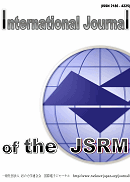This article provides a summary of part of a series of studies that received the Frontier Award of the Japanese Society for Rock Mechanics (JSRM) in the 2019 fiscal year. It is generally accepted that the physical and mechanical properties of rock materials change significantly based on clay mineral content; therefore, clay mineral content and type are considered to be significant factors in the mechanical properties of rock. In order to clarify the effect of clay mineral type, a series of experiments (one-dimensional swelling-pressure and constant-pressure permeability tests) have been carried out on clay mineral samples. In addition, uniaxial compressive test, using gypsum specimens mixed with clay minerals, were conducted to assess the effect of clay mineral type and content on the degree of strength reduction. Swelling-pressure and hydraulic conductivity of the clay mineral samples differed according to clay mineral type. Clay mineral content and type are also factors that affect uniaxial compressive strength values and the degree of strength reduction. Furthermore, the results suggested that the uniaxial compressive strength of clay mineral-bearing rock materials under dry conditions can be evaluated on the basis of the interlayer bonding force (i.e., the type of chemical bond) in clay minerals. Our results are a useful contribution to base data for evaluating the physical and mechanical properties of clay mineral-bearing rock materials.
View full abstract
